Productivity Of Arabica Coffee Varieties Under Pine Trees
DOI:
https://doi.org/10.38035/gijtm.v1i4.140Keywords:
Arabica Coffee Variety, Productivity, IntercroppingAbstract
The Community Forest Management (PHBM) program has attempted to increase soil productivity in forest areas by planting coffee under trees. The planting system used by Perhutani under PHBM is intercropping. This planting pattern aims to optimize the potential of land use for community welfare. This study aims to determine the Arabica coffee variety (Coffea arabica L.) with the highest productivity among pine stands at LMDH Campaka Bentang, Bandung Regency. The method used was experimental, with a completely randomized design (CRD) of five treatments with eight repetitions. The study was limited to five varieties of coffee plants grown by farmers with uniform coffee care or maintenance at the same planting date and in one plot. The results showed that the Ateng super variety had the highest average fruit weight per 100 seeds, the highest number of fruits, and the highest number of productive branches per tree, while the Ateng variety had the lowest value. The longest productive branch length per tree parameter was found in the Typica variety and the lowest in the Ateng variety. Further test results using Duncan's test with a 5% confidence level showed that the Ateng super variety had the highest value in the tested parameters compared to the other four varieties, while the lowest value was found in the Ateng variety.
References
Bote 2011. Effects Of Shade On Growth, Production And Quality Of Coffee (Coffea Arabica) In Ethiopia. Journal Of Horticulture And forestry 3 (11): 336 – 341.
Budiman H. 2012. Prospek Tinggi Bertanam Kopi. Yogyakarta: Pustaka Baru Press.
Ferry Y, Supriadi H, Ibrahim MSD. 2015. Teknologi budi daya tanaman kopi aplikasi pada perkebunan rakyat. Jakarta: IAARD Press
Firdaus MF, Ariffin. 2019. Karakteristik unsur lingkungan mikro pada tegakan hutan pinus (Pinus Merkusii Jungh) dan mahoni (Sweietenia Macrophylla King) di kawasan UB Forest. Jurnal Produksi Tanaman 7(3): 495 – 504.
Freitas AF, Nadaleti DHS, Silveira HRO, Carvalho GR, Venturin RP, Silva VA. 2020. Productivity and beverage sensory quality of arabica coffee intercropped with timber species. Pesq. agropec. bras., Brasília 55: e02240. DOI: 10.1590/S1678-3921.pab2020.v55.02240
Hapsari R, Indradewa D, Ambarwati D. 2017. Pengaruh pengurangan jumlah cabang pertumbuhan dan hasil tomat (Solanum lycopersicum L.). Vegetalika 6(3): 37 – 49.
Marisa H. 1990. Pengaruh Ekstrak Daun Pinus (Pinus merkusii Jungh. et de Vriese) terhadap Perkecambahan dan Pertumbuhan Vegetatif Tanaman Kedelai (Glycine max (L.) Merr.) [Tesis]. Institut Teknologi Bandung. Bandung.
Nurrochman, Trisnowati S, Muhartini S. 2013. Pengaruh pupuk kalium klorida dan umur penjarangan buah terhadap hasil dan mutu salak (Salacca zalacca (Gaertn.) Voss) ‘Pondoh Super’. Vegetalika 2(1): 3 – 12.
Rahardjo P. 2012. Kopi Panduan Budidaya dan Pengolahan Kopi Arabika dan Robusta. Penebar Swadaya. Jakarta.
Sobari L, Sakiroh, Purwanto EH. 2012. Pengaruh jenis tanaman penaung terhadap pertumbuhan dan persentase tanaman berbuah pada kopi arabika varietas kartika 1. Buletin RISTRI 3 (3): 217 – 222.
Utomo SB. 2011. Dinamika Suhu Udara Siang-Malam terhadap Fotorespirasi Fase Generatif Kopi Robusta di Bawah Naungan yang Berbeda pada Sistem Agroforestry [Tesis]. Universitas Jember. Jember.
Widiastuti L, Tohari, Sulistyaningsih E. 2004. Pengaruh intensitas cahaya dan kadar daminosida terhadap iklim mikro dan pertumbuhan tanaman krisan dalam pot. Ilmu Pertanian 11(2): 35 – 42.
Downloads
Published
How to Cite
Issue
Section
License
Copyright (c) 2024 Dwi Wahyuni, Aditya Sarif Hidayat, Ina Darliana

This work is licensed under a Creative Commons Attribution 4.0 International License.
Copyright :
Authors who publish their manuscripts in this journal agree to the following conditions:
- Copyright in each article belongs to the author.
- The author acknowledges that the Greenation International Journal of Tourism and Management (GIJTM) has the right to be the first to publish under a Creative Commons Attribution 4.0 International license (Attribution 4.0 International CC BY 4.0).
- Authors can submit articles separately, arrange the non-exclusive distribution of manuscripts that have been published in this journal to other versions (for example, sent to the author's institutional repository, publication in a book, etc.), by acknowledging that the manuscript has been published for the first time at GIJTM.


























